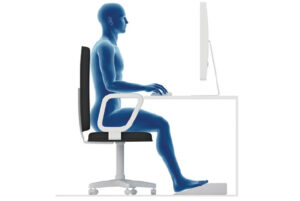Ergonomics

Introduction to Ergonomics
Ergonomics, derived from the Greek words “ergon” (work) and “nomos” (laws), is the science of designing and arranging things people use so that they can interact with them most efficiently and safely. It focuses on optimizing the interaction between humans and their work environments to enhance comfort, efficiency, and overall well-being.
The Importance of Ergonomics
Ergonomics is essential in preventing workplace injuries and improving productivity. Poor ergonomic practices can lead to musculoskeletal disorders (MSDs) such as carpal tunnel syndrome, tendonitis, and back pain. Implementing ergonomic principles helps in reducing these risks, leading to a healthier and more productive workforce.
Ergonomic Principles
• Workstation Design: A well-designed workstation promotes proper posture and reduces strain. Adjustable chairs, desks, and computer monitors help in maintaining a neutral body position. The top of the monitor should be at or slightly below eye level, and feet should rest flat on the floor or a footrest.
• Posture: Maintaining a neutral posture is crucial. This means keeping the spine in a natural S-curve, with shoulders relaxed and elbows close to the body. Avoiding slouching and regularly adjusting posture can prevent strain and discomfort.
• Movement and Breaks: Regular movement and breaks are vital in preventing fatigue and discomfort. The 20-20-20 rule is a useful guideline: every 20 minutes, take a 20-second break and look at something 20 feet away. This helps reduce eye strain and promotes overall well-being.
• Lighting: Proper lighting reduces eye strain and headaches. Natural light is ideal, but if that’s not possible, adjustable artificial lighting can help. Positioning monitors to avoid glare and using task lighting for detailed work are effective strategies.
Ergonomics in Different Work Environments
• Office Ergonomics: In an office setting, ergonomics focuses on workstation setup. Ergonomic chairs, adjustable desks, and properly placed computer peripherals are key components. Ensuring that the work area is organized and clutter-free also contributes to a more ergonomic environment.
• Industrial Ergonomics: In industrial settings, ergonomics addresses the physical demands of the job. This includes the design of tools, equipment, and workstations to minimize the risk of injury. Proper training in lifting techniques and the use of mechanical aids can significantly reduce the risk of musculoskeletal injuries.
• Remote Work Ergonomics: With the rise of remote work, creating an ergonomic home office is more important than ever. Investing in ergonomic furniture and setting up a dedicated workspace can improve comfort and productivity. It’s also important to establish a routine that includes regular breaks and physical activity.
Benefits of Ergonomics
• Increased Productivity: Ergonomic improvements can lead to higher productivity. When employees are comfortable and free from pain, they can focus better and work more efficiently.
• Reduced Absenteeism: By preventing work-related injuries and illnesses, ergonomics can reduce absenteeism. Employees are less likely to take time off due to discomfort or injury, leading to a more consistent workforce.
• Enhanced Employee Satisfaction: A comfortable work environment contributes to higher job satisfaction. Employees who feel cared for and valued are more likely to be engaged and motivated.
